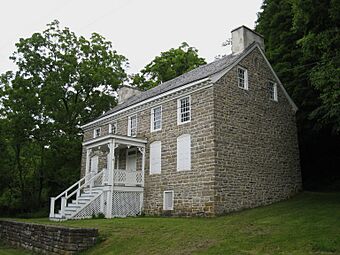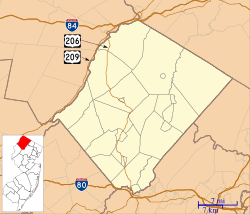Van Campen's Inn facts for kids
|
Isaac Van Campen Inn
|
|
|
U.S. Historic district
Contributing property |
|

Van Campen Inn in 2009
|
|
| Location | Old Mine Road Walpack Township |
|---|---|
| Part of | Old Mine Road Historic District (ID80000410) |
Quick facts for kids Significant dates |
|
| Designated CP | December 3, 1980 |
The Van Campen's Inn or Isaac Van Campen Inn is a historic stone house. It was once used as a special kind of inn called a "yaugh house" during the time when America was still a group of colonies. This old building is located in Walpack Township, Sussex County, New Jersey. It sits near the Delaware River along a very old road called the Old Mine Road. Today, it is part of the Delaware Water Gap National Recreation Area. The National Park Service and a local group called the Walpack Historical Society work together to take care of it.
Contents
The Inn's Early History
A Dutch family named Rosenkrans moved to the Minisink area around 1730. They bought a large piece of land near the Delaware River in 1742. Harmon Rosenkrans likely built the first part of the house around 1746. This first section was a "kitchen wing" on the north side of the house.
In 1754, Harmon Rosenkrans sold the property to his brother-in-law, Isaac Van Campen. Isaac was married to Harmon's sister, Magdalena Rosenkrans. Isaac Van Campen then built the larger, main part of the house. This main section is the building you see today. The older "kitchen wing" was taken down in 1917.
A Protected Historic Site
The Isaac Van Campen Inn was added to the National Register of Historic Places in 1980. This means it is recognized as an important historic site. It is part of the larger Old Mine Road Historic District.
The National Park Service began a big project to restore the inn in 1981. Workers carefully took apart two-thirds of the front and side walls. They built new foundations and made the back walls stronger. They also replaced the wooden beams inside the house. Local stonemason Clarence Sharp finished this restoration work in 1984.
What Was a Yaugh House?
Even though it's called an "inn," the Van Campen Inn was more like a "yaugh house." This was a type of rural home in a faraway area. Under colonial law, these homes were allowed to offer food and a place to sleep for travelers.
A Safe Place During Wars
During the French & Indian War (1754–1763), the Van Campen's Inn offered a safe place for settlers. People would go there for protection when Native American attacks were a threat. For example, in November 1763, about 150 settlers found shelter within the strong walls of the house.
The inn also played a role during the American Revolution. It is said that John Adams, who later became the second U.S. President, stayed there one night. He was traveling from Massachusetts to Philadelphia for the Continental Congress.
In December 1776, during a snowstorm, soldiers led by General Horatio Gates marched past the inn. They camped overnight nearby before continuing south to join General Washington at the Battle of Trenton. Later, in 1778, Brigadier General Pulaski, a Polish count, and his 250 cavalry soldiers spent the winter here. Isaac Van Campen himself served in the state government from 1782 to 1785.
Other Nearby Historic Sites
The Van Campen's Inn property once had a Dutch colonial-style barn. This barn had large, steep roofs and big double doors that swung inward. It was built around 1811 by Henry and John H. DeWitt. Sadly, this barn was destroyed by fire in 1971.
Fort Johns and Military Road
The ruins of Fort Johns are on a hillside near the inn. This fort was built during the French & Indian War (1754 to 1763). Fort Johns was the main base for the New Jersey Frontier Guard. It was the largest of about a dozen forts built to protect settlers along the Delaware River.
Fort Johns was at the end of Jonathan Hampton's Military Road. This road was built from 1755 to 1756. It connected the colony's capital, Elizabethtown (now Elizabeth, New Jersey), to Morristown. The road helped supply the forts in the Minisink area.
Today, a 1.6-mile part of the Military Road has been restored by the National Park Service. It is now called the "Military Trail." It starts from Walpack Centre and ends at the Old Mine Road, about half a mile north of Van Campen's Inn.
See also
- Tocks Island Dam Controversy
- List of the oldest buildings in New Jersey





